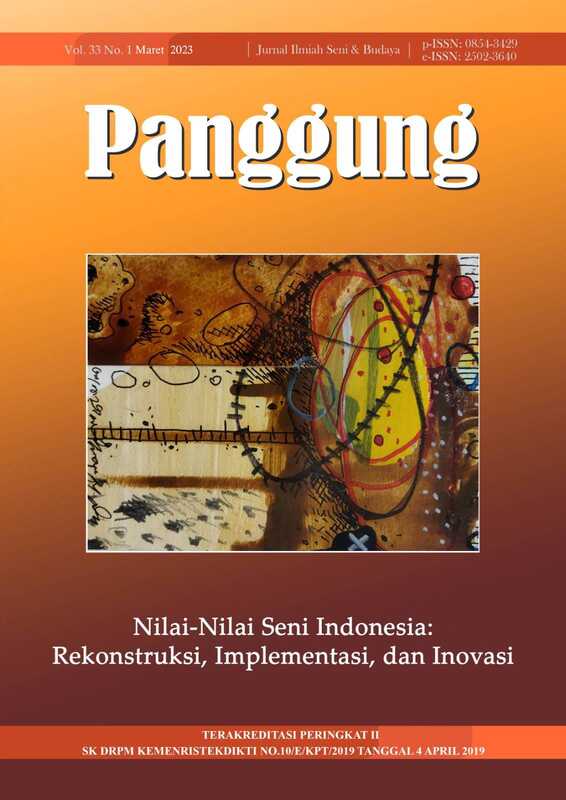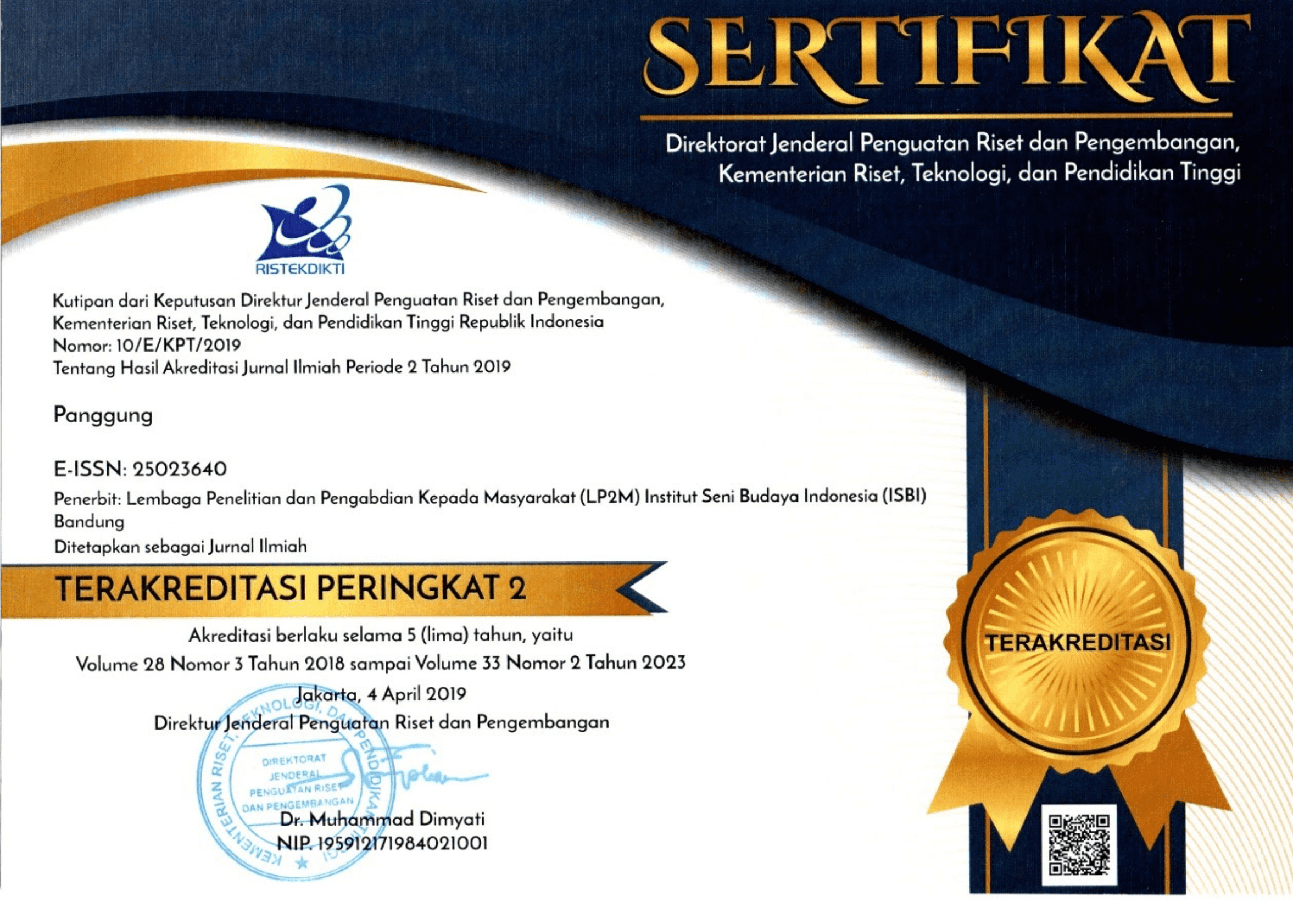Interaktivitas User Objek Imersif dalam Multiplayer Virtual Tour Museum Bank Indonesia
DOI:
https://doi.org/10.26742/panggung.v33i1.2328Abstract
Virtual Tour (VT) Museum Bank Indonesia merupakan aplikasi menelusuri ruang museum secara maya, tanpa harus datang ke museum. Namun, muncul permasalahan pengguna hanya menelusuri ruang tanpa mengakses artefak yang dipamerkan. Penelitian ini mengembangkan aplikasi dalam bentuk Multiplayer Virtual Tour yang dapat dimainkan oleh lebih dari satu orang pemain, dalam satu layar virtual. Tangan pengguna (user) bersama pengguna lain seakan-akan dapat menyentuh artefak yang ditampilkan secara maya. Muncul keingintahuan impak efektivitas pembacaan materi pameran dengan menghadirkan konten imersif. Penelitian ini bertujuan menelaah respon pengguna dari segi usability dan interactivity. Secara metodologis, penelitian dianalisis dengan metode Miles and Huberman. Hasil kajian mengungkap bahwa aspek usability MVT terlihat lebih menarik. Pengunjung mengamati lebih detail materi pameran. Pengunjung tidak merasa sendirian, serasa dalam permainan game. Simpulan dalam penelitian ini menegaskan bahwa interaktivitas dibangun dengan keigintahuan pengalaman bermain-main dengan artefak imersif. MVT memunculkan kembali esensi pengunjung yang sejatinya makhluk sosial yang selalu ingin berinteraksi. Kata kunci: imersif, interaktivitas, kehadiran sosial, multiplayer virtual tour, museum.
References
Arrighi, G., See, Z. S., & Jones, D. (2021). Victoria Theatre virtual reality: A digital heritage case study and user experience design. Digital Applications in Archaeology and Cultural Heritage, 21, e00176. https://doi.org/10.1016/j.daach.2021.e00176
Ausubel, D. P. (2000). The aquisition and retention of knowledge: A cognitive view. Springer. Bai, S., Hew, K. F., Gonda, D. E., Huang, B., & Liang, X. (2022). Incorporating fantasy into gamification promotes student learning and quality of online interaction. International Journal of Educational Technology in Higher Education, 19(29), 1–26. https://doi.org/10.1186/s41239-022-00335-9
Bran, E., Bautu, E., & Popovici, D. M. (2020). Towards a sustainable future: Ubiquitous knowledge mixed reality museum. Procedia Computer Science, 176, 2878–2885. https://doi.org/10.1016/j.procs.2020.09.266
Burch, T. K. (2001). Longitudinal research in social science: Some theoretical challenges. Canadian Studies in Population, 28(2), 263–283. https://doi.org/10.25336/p6h30p
Caggianese, G., Gallo, L., & Neroni, P. (2018). Evaluation of spatial interaction techniques for virtual heritage applications: A case study of an interactive holographic projection. Future Generation Computer Systems, 81, 516–527. https://doi.org/10.1016/j.future.2017.07.047
Camps-Ortueta, I., Escolar, L. D., & López, M. F. B. (2021). New technology in museums: AR and VR video games are coming. Communication and Society, 34(2), 193–210. https://doi.org/10.15581/003.34.2.193-210
Carvajal, L. D. A., Morita, M. M., & Bilmes, G. M. (2020). Virtual museums. Captured reality and 3D modeling. Journal of Cultural Heritage, 45, 234–239. https://doi.org/10.1016/j.culher.2020.04.013
Chen, C. A., & Lai, H. I. (2021). Application of augmented reality in museums – Factors influencing the learning motivation and effectiveness. Science Progress, 104(3), 1–16. https://doi.org/10.1177/00368504211059045
Chen, H., & Ryan, C. (2020). Transforming the museum and meeting visitor requirements: The case of the Shaanxi History Museum. Journal of Destination Marketing and Management, 18(August), 100483. https://doi.org/10.1016/j.jdmm.2020.100483
Clark, R. C., & Mayer, R. E. (2016). E-learning and the science of instruction: Proven guidelines for consumers and designers of multimedia learning (4th ed.). John Wiley & Sons.
Du, J., Shi, Y., Mei, C., Quarles, J. (2016) Communication by Interaction: A Multiplayer VR Environment for Building Walkthroughs. Conference: Construction Research Congress. https://doi.org/10.1061/9780784479827.227
Farah, M. F., Ramadan, Z. B., & Harb, D. H. (2019). The examination of virtual reality at the intersection of consumer experience, shopping journey and physical retailing. Journal of Retailing and Consumer Services, 48, 136–143. https://doi.org/10.1016/j.jretconser.2019.02.016
Froschauer, J., Arends, M., Goldfarb, D., & Merkl, D. (2011). Towards an online multiplayer serious game providing a joyful experience in learning art history. Proceedings - 2011 3rd International Conferenceon Games and
Virtual Worlds for Serious Applications, VS-Games 2011, June, 160–163. https://doi.org/10.1109/VS-GAMES.2011.47
Gran, A. B., Lager Vestberg, N., Booth, P., & Ogundipe, A. (2019). A digital museum’s contribution to diversity–a user study. Museum Management and Curatorship, 34(1), 58–78. https://doi.org/10.1080/09647775.2018.1497528
Haris, D. A., Mawardi, V. C., Pratama, D. (2021). Developing Multiplayer Online Game “KNIGHT FANTASY ONLINE”. Journal of Games, Games Arts, and Gamification. Vol. 5 No. 1: Special Issue: International Conference of Games, Game Art and Gamification (ICGGA). https://doi.org/10.21512/jggag.v5i1.7469
Hajirasouli, A., Banihashemi, S., Kumarasuriyar, A., Talebi, S., & Tabadkani, A. (2021). Virtual reality-based digitisation for endangered heritage sites: Theoretical framework and application. Journal of Cultural Heritage, 49, 140–151. https://doi.org/10.1016/j.culher.2021.02.005
Huang, Y. C., & Han, S. R. (2014). An immersive virtual reality museum via second life: Extending art appreciation from 2D to 3D. Communications in Computer and Information Science, 579–584. https://doi.org/10.1007/978-3-319-07857-1_102
Jewitt, C., Chubinidze, D., Price, S., Yiannoutsou, N., & Barker, N. (2021). Making sense of digitally remediated touch in virtual reality experiences. Discourse, Context & Media, 41, 100483. https://doi.org/10.1016/j.dcm.2021.100483
Kamariotou, V., Kamariotou, M., & Kitsios, F. (2021). Strategic planning for virtual exhibitions and visitors’ experience: A multidisciplinary approach for museums in the digital age. Digital Applications in Archaeology and Cultural Heritage, 21, e00183. https://doi.org/10.1016/j.daach.2021.e00183
Kim, H., So, K. K. F., Mihalik, B. J., & Lopes, A. P. (2021). Millennials’ virtual reality experiences pre- and post-COVID-19. Journal of Hospitality and Tourism Management, 48(May), 200–209. https://doi.org/10.1016/j.jhtm.2021.06.008
Kotler, P., & Keller, L. K. (2016). Marketing management. Pearson Education. Lee, H., Jung, T. H., tom Dieck, M. C., & Chung, N. (2020). Experiencing immersive virtual reality in museums. Information and Management, 57(5), 103229. https://doi.org/10.1016/j.im.2019.103229
Li, C. (2021). Art image simulation design of craft products based on virtual reality and human–computer interactive processing. Journal of Ambient Intelligence and Humanized Computing, 0123456789. https://doi.org/10.1007/s12652-021-3117-9
Listiani, W., Rustiyanti, S., Sari, F. D., & Peradantha, I. S. (2019). Augmented reality Pasua Pa sebagai alternatif media pembelajaran seni pertunjukan 4.0. Panggung, 29(3), 269–283. https://doi.org/10.26742/panggung.v29i3.1012
López-Martínez, A., Carrera, Á., & Iglesias, C. A. (2020). Empowering museum experiences applying gamification techniques based on linked data and smart objects. Applied Sciences (Switzerland), 10(16), 1–22. https://doi.org/10.3390/APP10165419
Loureiro, S. M. C., Guerreiro, J., & Ali, F. (2020). 20 years of research on virtual reality and augmented reality in tourism context: A text-mining approach. Tourism Management, 77(November 2019). https://doi.org/10.1016/j.tourman.2019.104028
Margetis, G., Apostolakis, K. C., Ntoa, S., Papagiannakis, G., & Stephanidis, C. (2021). X-reality museums: Unifying the virtual and realworld towards realistic virtual museums. Applied Sciences (Switzerland), 11(1), 1–16. https://doi.org/10.3390/app11010338
Mayer, R. E. (2009). Multimedia learning (2nd ed.). Cambridge Unversity Press. Miles, M. B., Huberman, A. M., & Saldana, J. (2014). Qualitative data analysis: A methods sourcebook (3rd ed.). Sage Publication.
Mitchell, A., Linn, S., & Yoshida, H. (2019). A tale of technology and collaboration: Preparing for 21st-centuru museum visitiors. Journal of Museum Education, 44(3), 242–252. https://doi.org/10.1080/10598650.2019.1621141
Moldoveanu, A., Moldoveanu, F., Soceanu, A., & Asavei, V. (2008). A 3D virtual museum. UPB Scientific Bulletin, Series C: Electrical Engineering and Computer Science, 70(3), 47–58.
Murwonugroho, W. (2019). Mediating role of social media in the memorability of street sculpture art: Jogja Street sculpture Project 2017 as case study. Wacana Seni, 18, 95–124. https://doi.org/10.21315/ws2019.18.5
Murwonugroho, W., & Atwinita, S. (2020). Pelatihan penguatan teknik dasar fotografi dan teknik lampu studio pada sesi pemotretan model. PKM: Pengabdian Kepada Masyarakat, 03(01), 114–122.
Murwonugroho, W., & Tyasrinestu, F. (2019). Visual playability in jogja video mapping. International Journal of Scientific and Technology Research, 8(10), 3395–3400.
Noehrer, L., Gilmore, A., Jay, C., & Yehudi, Y. (2021). The impact of COVID-19 on digital data practices in museums and art galleries in the UK and the US. Humanities and Social Sciences Communications, 8(1), 1–10. https://doi.org/10.1057/s41599-021-00921-8
O’leary, Z. (2017). The essential guide to doing your research project (3rd ed.). Sage Publication.
Oh, C., Herrera, F., & Bailenson, J. (2019). The effects of immersion and real-world distractions on virtual social interactions. Cyberpsychology, Behavior, and Social Networking, 22(6), 365–372. https://doi.org/10.1089/cyber.2018.0404
Parker, D. H. (2019). The principles of aesthetics. MJP Publishers.
Pengnate, S., Riggins, F. J., & Zhang, L. (2020). Understanding users’ engagement and responses in 3D virtual reality: The influence of presence on user value. Interacting with Computers, 32(2), 103–117. https://doi.org/10.1093/iwc/iwaa008
Pivec, M., & Kronberger, A. (2016). Virtual museum : Playful visitor experience in the real and virtual world. 2016 8th International Conference on Games and Virtual Worlds for Serious Applications (VS-GAMES). https://doi.org/10.1109/VSGAMES37200.2016
Roth, D., Kleinbeck, C., Feigl, Mutschler, C., & Latoschik, M. E. (2017). Social augmentations in multi-user virtual reality: A virtual museum experience. IEEE International Symposium on Mixed and Augmented Reality Adjunct Proceedings [POSTER], 42–43. https://doi.org/10.1109/ISMAR-Adjunct.2017.28
Rustiyanti, S., Listiani, W., Sari, F. D., & Peradantha, I. B. G. S. (2020). Literasi tubuh virtual dalam aplikasi teknologi augmented reality Pasua Pa. Panggung, 30(3), 454–464. https://doi.org/10.26742/panggung.v30i3.1271
Schwan, S., Dutz, S., & Dreger, F. (2018). Multimedia in the wild: Testing the validity of multimedia learning principles in an art exhibition. Learning and Instruction, 55, 148–157. https://doi.org/10.1016/j.learninstruc.2017.10.004
Setiawan, D., Haryono, T., & Burhan, M. A. (2014). Prinsip estetika pakaian cosplay yogyakarta: Fantasi dan ekspresi desain masa kini. Panggung, 24(1), 39–48. https://doi.org/10.26742/panggung.v24i1.103
Schepper, T. D., Braem B., Latré, S. (2015). A Virtual Reality-based Multiplayer Game using Fine-grained Localization. Conference: Global Information Infrastructure and Networking Symposium (GIIS). https://doi.org/10.1109/GIIS.2015.7347176
Shirai, A., Kose, Y., Minobe, K., & Kimura, T. (2016). Gamification and construction of virtual field museum by using augmented reality game “Ingress.” ACM International Conference Proceeding Series. https://doi.org/10.1145/2806173.2806182
Theodoropoulos, A., & Antoniou, A. (2022). VR games in cultural heritage: A systematic review of the emerging fields of virtual reality and culture games. Applied Sciences (Switzerland), 12(17), 1–19. https://doi.org/10.3390/app12178476
Urban, R., Marty, P., & Twidale, M. (2007). A second life for your museum: 3D multiuser virtual environments and museums. Museums and the Web 2007: Proceedings.
Wu, X., & Lai, I. K. W. (2021). Identifying the response factors in the formation of a sense of presence and a destination image from a 360-degree virtual tour. Journal of Destination Marketing and Management, 21(January), 100640. https://doi.org/10.1016/j.jdmm.2021.100640
Zhang, G., Cao, J., Liu, D., & Qi, J. (2022). Popularity of the metaverse: Embodied social presence theory perspective. Frontiers in Psychology, 13, 1–13. https://doi.org/10.3389/fpsyg.2022.997751
Downloads
Published
How to Cite
Issue
Section
Citation Check
License
Penulis yang menerbitkan jurnal ini menyetujui persyaratan berikut:
Penulis memiliki hak cipta dan memberikan jurnal hak publikasi pertama dengan karya yang secara simultan dilisensikan di bawah Creative Commons Attribution License yang memungkinkan orang lain untuk berbagi karya dengan pengakuan kepengarangan karya dan publikasi awal dalam jurnal ini.
Penulis dapat mengadakan perjanjian kontrak tambahan yang terpisah untuk distribusi non-eksklusif versi jurnal yang diterbitkan dari karya tersebut (misalnya, mempostingnya ke repositori institusional atau menerbitkannya dalam sebuah buku), dengan pengakuan atas publikasi awalnya dalam jurnal ini.
Penulis diizinkan dan didorong untuk memposting pekerjaan mereka secara online (mis., Dalam repositori institusional atau di situs web mereka) sebelum dan selama proses pengiriman, karena dapat menyebabkan pertukaran yang produktif, serta kutipan yang lebih awal dan lebih besar dari karya yang diterbitkan.
Authors who publish with this journal agree to the following terms:
Authors retain copyright and grant the journal right of first publication with the work simultaneously licensed under a Creative Commons Attribution License that allows others to share the work with an acknowledgement of the work's authorship and initial publication in this journal.
Authors are able to enter into separate, additional contractual arrangements for the non-exclusive distribution of the journal's published version of the work (e.g., post it to an institutional repository or publish it in a book), with an acknowledgement of its initial publication in this journal.
Authors are permitted and encouraged to post their work online (e.g., in institutional repositories or on their website) prior to and during the submission process, as it can lead to productive exchanges, as well as earlier and greater citation of published work.





